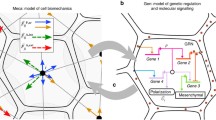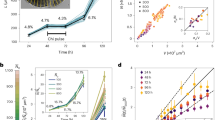Abstract
The phenomenon of scaling, i.e., preserving the proportions of the embryo’s spatial pattern in dependence on its overall size, is the most prominent feature of the embryonic morphogenetic fields. Up to now, attempts to understand the mechanisms of scaling have been limited to the creation and analysis of the behavior of theoretical models that, to some extent, reproduce this phenomenon in silico. Only recently, when creating such models, scientists began to use experimental data on specific genes and their products (secreted proteins), which were identified during the study of various molecular mechanisms in embryogenesis. However, no approaches for the targeted identification of genes and proteins that are directly responsible for the embryonic scaling have been described in the literature so far. Developing such approaches and putting them into practice is an important task for future research. In this work, the main current publications on the problem of embryonic scaling and possible approaches to studying the mechanisms of this phenomenon are reviewed.

Similar content being viewed by others
REFERENCES
Almuedo-Castillo, M., Bläßle, A., Mörsdorf, D., et al., Scale-invariant patterning by size-dependent inhibition of Nodal signalling, Nat. Cell Biol., 2018, vol. 20, no. 9, pp. 1032–1042.
Angerer, L.M., Yaguchi, R., Angerer, R., and Burke, R.D., The evolution of nervous system patterning: insights from sea urchin development, Development, 2011, vol. 138, no. 17, pp. 3613–3623.
Belintsev, B.N., Dissipative structures and the problem of biological morphogenesis, Usp. Fiz. Nauk, 1983, vol. 141, no. 1, pp. 55–101.
Belousov, L.V. and Bogdanovskii, S.B., Cellular mechanisms of embryonic regulations in sea urchins, Ontogenez, 1980, vol. 11, pp. 467–475.
Ben-Zvi, D. and Barkai, N., Scaling of morphogen gradients by an expansion-repression integral feedback control, Proc. Natl. Acad. Sci. U. S. A., 2010, vol. 107, no. 15, pp. 6924–6929. https://doi.org/10.1073/pnas.0912734107
Ben-Zvi, D., Shilo, B.-Z., Fainsod, A., and Barkai, N., Scaling of the BMP morphogen activation gradient in Xenopus embryos, Nature, 2008, vol. 453, no. 7199, pp. 1205–1211.
Ben-Zvi, D., Pyrowolakis, G., Barkai, N., and Shilo, B.-Z., Expansion-repression mechanism for scaling the Dpp activation gradient in Drosophila wing imaginal discs, Curr. Biol., 2011, vol. 21, no. 16, pp. 1391–1396.
Cui, N., Hu, M., and Khalil, R.A., Biochemical and biological attributes of matrix metalloproteinases, Prog. Mol. Biol. Transl. Sci., 2017, vol. 147, pp. 1–73.
Dawes, J.H., The emergence of a coherent structure for coherent structures: localized states in nonlinear systems, Phil. Trans. A, 2010, vol. 368, no. 1924, pp. 3519–3354.
Driesch, H., Der Werth der beiden ersten Furchungszellen in der Echinodermentwicklung. Experimentelle Erzeugung von Theil und Doppelbildungen, Z. Wiss. Zool., 1891, vol. 53, pp. 160–178.
DuBuc, T.Q., Stephenson, T.B., Rock, A.Q., and Martindale, M.Q., Hox and Wnt pattern the primary body axis of an anthozoan cnidarian before gastrulation, Nat. Com., 2018, vol. 9, no. 1, p. 2007.
Eldar, A., Dorfman, R., Weiss, D., et al., Robustness of the BMP morphogen gradient in drosophila embryonic patterning, Nature, 2002, vol. 419, pp. 304–308.
Eom, D.S., Bain, E.J., Patterson, L.B., et al., Long-distance communication by specialized cellular projections during pigment pattern development and evolution, Elife, 2015, vol. 4, pp. 2686–2695.
Fritzenwanker, J.H., Genikhovich, G., Kraus, Y., and Technau, U., Early development and axis specification in the sea anemone Nematostella vectensis, Dev. Biol., 2007, vol. 310, no. 2, pp. 264–279.
Genikhovich, G., Fried, P., Prünster, M.M., et al., Axis patterning by BMPs: cnidarian network reveals evolutionary constraints, Cell. Rep., 2015, vol. 10, no. 10, pp. 1646–1654.
Gierer, A. and Meinhardt, H., A theory of biological pattern formation, Kybernetik, 1972, vol. 12, no. 1, pp. 30–39.
Green, J.B.A. and Sharpe, J., Positional information and reaction-diffusion: two big ideas in developmental biology combine, Development, 2015, vol. 142, no. 7, pp. 1203–1211.
Gregor, T., Tank, D.W., Wieschaus, E.F., and Bialek, W., Probing the limits to positional information, Cell, 2007, vol. 130, no. 1, pp. 153–164.
Horstadius, S., The mechanisms of sea urchin development, studied by operative methods, Biol. Rev., 1939, vol. 14, no. 2, pp. 132–179.
Houchmandzadeh, B., Wieschaus, E., and Leibler, S., Establishment of developmental precision and proportions in the early Drosophila embryo, Nature, 2002, vol. 415, no. 6873, pp. 798–802.
Inomata, H., Shibata, T., Haraguchi, N., and Sasai, Y., Scaling of dorsal-ventral patterning by embryo size-dependent degradation of Spemann’s organizer signals, Cell, 2013, vol. 153, no. 6, pp. 1296–1311.
Inomata, H., Scaling of pattern formations and morphogen gradients, Dev. Growth Diff., 2017, vol. 59, no. 1, pp. 41–51.
Leclère, L., Bause, M., Sinigaglia, C., et al., Development of the aboral domain in Nematostella requires β-catenin and the opposing activities of Six3/6 and Frizzled5/8, Development, 2016, vol. 143, no. 10, pp. 1766–1777.
Lee, J.Y., Choi, H.Y., Ahn, H.J., et al., Matrix metalloproteinase-3 promotes early blood-spinal cord barrier disruption and hemorrhage and impairs long-term neurological recovery after spinal cord injury, Am. J. Pathol., 2014, vol. 184, no. 11, pp. 2985–3000.
Levin, M., Morphogenetic fields in embryogenesis, regeneration, and cancer: non-local control of complex patterning, BioSystems, 2012, vol. 109, no. 3, pp. 243–261.
Magie, C.R., Daly, M., and Martindale, M.Q., Gastrulation in the cnidarian Nematostella vectensis occurs via invagination not ingression, Dev. Biol., 2007, vol. 305, no. 2, pp. 483–497.
Meinhardt, H., Models of biological pattern formation: from elementary steps to the organization of embryonic axes, Curr. Topics Dev. Biol., 2008, vol. 81, no. 7, pp. 1–63.
Meinhardt, H., Models for the generation and interpretation of gradients, Cold Spring Harb. Perspect. Biol., 2009, vol. 1, no. 4. a001362.
Müller, P., Rogers, K.W., Jordan, B.M., et al., Differential diffusivity of Nodal and Lefty underlies a reaction-diffusion patterning system, Science, 2012, vol. 336, no. 6082, pp. 721–724.
Mathematical Biology II: Spatial Models and Biomedical Applications, Murray, J.D., Ed., New York: Springer-Verlag, 1993.
Okabe-Oho, Y., Murakami, H., Oho, S., and Sasai, M., Stable, precise, and reproducible patterning of bicoid and hunchback molecules in the early Drosophila embryo, PLoS Comput. Biol., 2009, vol. 5, no. 8. e1000486.
Porcher, A. and Dostatni, N., The bicoid morphogen system, Curr. Biol., 2010, vol. 20, no. 5, pp. R249–R254.
Putnam, N.H., Srivastava, M., Hellsten, U., et al., Sea anemone genome reveals ancestral eumetazoan gene repertoire and genomic organization, Science, 2007, vol. 317, no. 5834, pp. 86–94.
Rasolonjanahary, M. and Vasiev, B., Scaling of morphogenetic patterns in reaction–diffusion systems, J. Theor. Biol., 2016, vol. 404, pp. 109–119.
Satoh, K. and Kominami, T., Initial observation of potential factors involved in the specification process of oral-aboral axis in the sand dollar Scaphechinus mirabilis, Dev. Growth Differ., 2008, vol. 50, no. 8, pp. 675–687.
Schmierer, B., Tournier, A.L., Bates, P.A., and Hill, C.S., Mathematical modeling identifies Smad nucleocytoplasmic shuttling as a dynamic signal interpreting system, Proc. Natl. Acad. Sci. U. S. A., 2008, vol. 105, no. 18, pp. 6608–6613.
Shingleton, A.W., Frankino, W.A., Flatt, T., et al., Size and shape: the developmental regulation of static allometry in insects, BioEssays, 2007, vol. 29, no. 6, pp. 536–548.
Sick, S., Reinker, S., Timmer, J., and Schlake, T., WNT and DKK determine hair follicle spacing through a reaction–diffusion mechanism, Science, 2006, vol. 314, no. 5804, pp. 1447–1450.
Sodergren, E., Weinstock, G.M., Davidson, E.H., et al., The genome of the sea urchin Strongylocentrotus purpuratus, Science, 2006, vol. 314, no. 5801, pp. 941–952.
Teleman, A.A. and Cohen, S.M., Dpp gradient formation in the Drosophila wing imaginal disc, Cell, 2000, vol. 103, no. 6, p. 10.
Turing, A., The chemical basis of morphogenesis, Phil. Trans. R. Soc. Lond. B, 1952, vol. 237, no. 641, pp. 37–72.
Umulis, D.M., Analysis of dynamic morphogen scale invariance, J. R. Soc. Interface, 2009, vol. 6, no. 41, pp. 1179–1191.
Umulis, D.M. and Othmer, H.G., Mechanisms of scaling in pattern formation, Development, 2013, vol. 140, no. 24, pp. 4830–4843.
Vacquier, V.D. and Mazia, D., Twinning of sea urchin embryos by treatment with dithiothreitol. Roles of cell surface interactions and of the hyaline layer, Exp. Cell Res., 1968, vol. 52, nos. 2–3, pp. 459–468.
Warner, J.F., Guerlais, V., Amiel, A.R., et al., NvERTx: a gene expression database to compare embryogenesis and regeneration in the sea anemone Nematostella vectensis, Development, 2018, vol. 145, no. 10. dev162867.
Wartlick, O., Kicheva, A., and González-Gaitán, M., Morphogen gradient formation, Cold Spring Harb. Perspect. Biol., 2009, vol. 1, no. 3. a001255
Wartlick, O., Mumcu, P., Kicheva, A., et al., Dynamics of Dpp signaling and proliferation control, Science, 2011, vol. 331, no. 6021, pp. 1154–1159.
Wolpert, L., Positional information and the spatial pattern of cellular differentiation, J. Theor. Biol., 1969, vol. 25, no. 1, pp. 1–47.
Yamaguchi, M., Yoshimoto, E., and Kondo, S., Pattern regulation in the stripe of zebrafish suggests an underlying dynamic and autonomous mechanism, Proc. Natl. Acad. Sci. U. S. A., 2007, vol. 104, no. 12, pp. 4790–4793.
FUNDING
This study was supported by the Russian Science Foundation (project no. 14-14-00557P).
Author information
Authors and Affiliations
Corresponding authors
Additional information
Translated by M. Batrukova
Rights and permissions
About this article
Cite this article
Nesterenko, A.M., Zaraisky, A.G. The Mechanisms of Embryonic Scaling. Russ J Dev Biol 50, 95–101 (2019). https://doi.org/10.1134/S1062360419030044
Received:
Revised:
Accepted:
Published:
Issue Date:
DOI: https://doi.org/10.1134/S1062360419030044




